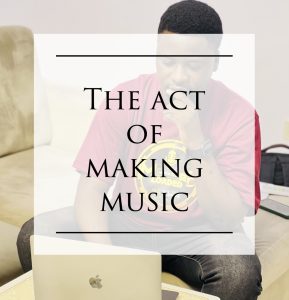The Act of Making Music

Making Music : The Act
The act of making music is a deeply enriching and multifaceted process that transcends cultural boundaries and has been a fundamental part of human expression for centuries.
From the earliest civilizations to the present day, music has played a significant role in various aspects of society, including religious rituals, cultural traditions, storytelling, entertainment, and emotional catharsis.
In its essence, making music involves the manipulation of sound elements to create a cohesive and meaningful artistic experience. This can encompass a wide range of activities, each contributing to the overall creation and production of music.
Composition lies at the heart of music-making, where artists conceive and develop musical ideas, motifs, melodies, harmonies, and structures. Composers draw inspiration from diverse sources such as personal experiences, nature, literature, historical events, and societal issues. They harness their creativity and skill to arrange these musical elements into coherent and captivating compositions.
Musicians, whether instrumentalists or vocalists, bring these compositions to life through their technical proficiency, interpretative abilities, and emotional depth. They use their instruments, voices, and bodies as vehicles to convey the intended message and evoke emotional responses from listeners. Musicians may perform solo, as part of an ensemble, or collaborate with other artists to explore different musical dynamics and create unique sonic experiences.
Improvisation is another essential aspect of music-making, particularly prevalent in genres like jazz, blues, and certain forms of world music. It involves spontaneous composition and performance, where musicians create music on the spot, responding to the energy of the moment and interacting with other musicians in a dialogue of sounds.
The advent of technology has revolutionized the music-making process, providing musicians with a vast array of tools and resources to explore new creative possibilities. Digital audio workstations (DAWs), virtual instruments, synthesizers, and samplers enable musicians to manipulate and sculpt sounds, experiment with textures and effects, and produce intricate and complex compositions.
Music production encompasses the technical and artistic aspects of capturing, editing, and refining recorded music. Producers and engineers work closely with musicians to achieve the desired sonic vision, employing techniques such as equalization, compression, and spatial effects to shape the sound and create a polished final product.
Furthermore, making music is not confined to the realm of professionals. It is a universal human endeavor that can be enjoyed by individuals of all ages and backgrounds. Many people engage in music-making as a hobby, seeking personal fulfillment, stress relief, and a means of self-expression. Whether strumming a guitar, playing a piano, singing in a choir, or experimenting with electronic music production, the act of making music provides a profound sense of joy and satisfaction.
Moreover, music-making fosters collaboration and community-building. Musicians often come together to form bands, orchestras, choirs, and ensembles, forging connections and shared experiences through their mutual love for music. The collaborative nature of music-making allows for the exchange of ideas, the blending of diverse musical influences, and the creation of unique and innovative works.
The act of making music is a rich and transformative process that encompasses composition, performance, improvisation, and production. It serves as a powerful medium of expression, enabling individuals to communicate, connect, and evoke emotions in ways that transcend language barriers. Whether as a professional pursuit or a personal hobby, making music is a testament to the boundless creativity and inherent human need for artistic expression.
The act of making music involves various elements and steps. Here are some key components involved in the process of creating music:
Making Music
1. Inspiration:
Music creation often begins with an initial spark of inspiration. This can come from personal experiences, emotions, events, or even other works of art.
2. Songwriting: Depending on your musical style, songwriting involves crafting lyrics, melodies, chord progressions, and arrangements. This can be done through brainstorming, experimenting with instruments, or using songwriting techniques like hooks, bridges, and verses.
3. Composition: If you’re creating instrumental music, composition takes the place of songwriting. This involves developing musical ideas, melodies, harmonies, and structures while considering the intended mood and meaning of the piece.
4. Instrumentation and Arrangement: Once the core ideas of a song or composition are established, the next step is determining which instruments and sounds will be used. This may involve playing instruments yourself, hiring musicians, or utilizing virtual instruments and samples. Arrangement refers to deciding how the different musical elements fit together, such as the layering of instruments, dynamics, and overall structure of the piece.
5. Recording: Recording involves capturing your music using microphones, audio interfaces, and recording software. This step can take place in a professional recording studio or a home studio setup. It’s important to capture high-quality audio and consider factors like mic placement, signal flow, and sound engineering techniques.
6. Editing: After the initial recording, editing focuses on refining the recorded tracks. This can include tasks like adjusting timing, pitch correction, removing unwanted noise, and enhancing overall sound quality. Editing software is commonly used during this stage.
7. Mixing: Mixing is the process of balancing and blending all the individual tracks to create a pleasing and cohesive final sound. It involves adjusting volume levels, panning, equalization, effects (reverb, delay, etc.), and creating a stereo image. The goal is to ensure every element is heard clearly and works together harmoniously.
8. Mastering: Mastering is the final step in music production. It involves preparing the mixed track or album for distribution by enhancing its overall sound, ensuring consistent loudness, and making it compatible with different playback systems. Mastering engineers use specialized software and techniques to bring out the best qualities in the music and make it sound polished and professional.
9. Performance and Live Shows: If you plan to perform your music live, you may need to rehearse with your bandmates or session musicians, develop a stage presence, and coordinate aspects like lighting and sound equipment. Live performances allow you to connect with your audience and showcase your music in a dynamic and interactive setting.
10. Publishing and Distribution: Once your music is complete, you can explore options for publishing and distributing your work. This involves copyrighting your compositions, securing licensing agreements if needed, and choosing the right platforms (streaming services, online distributors, physical copies, etc.) to make your music available to the public.
Remember, making music is a personal and creative process, and there are no strict rules to follow. Let your creativity and passion guide you as you embark on your musical journey.


![[Video] Johnbull ft Erriga X Sugarboy X Mr Razzy – Samakwe](https://mrbloaded.com/wp-content/uploads/2021/10/FB_IMG_1633866456923.jpg)
![[Video] Labans – Shawty](https://mrbloaded.com/wp-content/uploads/2021/07/02-Labans-Shawty-Artwork-scaled.jpg)
![[Video & Audio] Harrysong ft Rudeboy – Kona](https://mrbloaded.com/wp-content/uploads/2020/11/Harrysong-Right-About-Now-EP-art.jpg)


![[Music] De material – Wizkid](https://mrbloaded.com/wp-content/uploads/2020/06/IMG_20200624_163102_478.jpg)


![[Music] Johnbull – Samakwe ft Erigga X Sugar Boy X Mr Razzy](https://mrbloaded.com/wp-content/uploads/2020/06/Screenshot_20200623-1132462.png)
